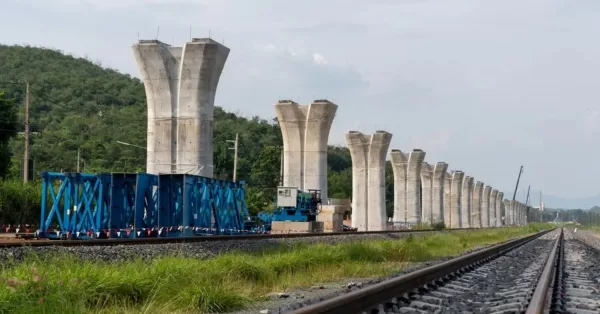Bangkok-Laos high-speed railway is a train system that will be the first HSR in Thailand. Since 2017, the project experienced several delays but is now moving forward to link Thailand with China.
Bangkok-Laos high-speed Railway overview
The Bangkok-Nong Khai high-speed railway (HSR) is an ongoing cross-country railway system that is currently under construction. The railway system project is part of a significant undertaking by Thailand to connect the country to China through Laos. The Bangkok-Nong Khai HSR line will run across the Mekong River.
The HSR in Bangkok will also connect to the Kunming-Singapore railway. This endeavor cements the HSR project as a significant regional connection for the entire ASEAN region. The railway project in Thailand aligns with the Belt and Road Initiative (BRI) of the government of the People’s Republic of China.
The project was first approved by the State of Railway of Thailand (SRT) in 2017 and began construction in the same year. The cross-country railway is a partnership project between Thailand and the People’s Republic of China (PRC).
The government of Thailand will take the reigns of the project and shoulder the project cost of $5 billion. The government of China will be responsible for the design, civil works, procurement of trains, and implementation of Chinese technology for railway construction.
The high-speed railway will span 873 kilometers long. The project will connect Bangkok with Laos, which will then connect with China through the China-Laos Railway which is part of China’s BRI initiative. Once complete, the connected railway systems will make it possible for commuters to travel from Bangkok, Thailand to Kunming, China.
Also read: LED Expo Thailand

Several challenges and delays
From inception, the Bangkok-Laos high-speed railway project will have multiple construction phases. The first phase, which will run from Bangkok to Nakhon Ratchasima, will be operational in 2026. The remaining stations from Nong Khai to Vientiane, Laos, will be operational by 2028.
However since the Bangkok-Nong Khai high-speed railway began construction work in 2017, the project has seen significant delays. The project’s delays are attributed to the significant costs and advanced technology required to accomplish the monumental cross-country project.

Thailand remains optimistic on the railway to China
The Prime Minister of Thailand, Srettha Thavisin, has been optimistic about the high-speed railway stating that the railway project aligns with his economic agenda. “Thailand will enhance the connection with the China-Laos Railway,” the Prime Minister said in an interview with Xinhua, a Chinese state media agency.
Despite all the delays and disputes over financing for the project, Thailand built the Bangkok-Nakhon Ratchasima section of the railway successfully. This is the first phase of the project and was officially launched by the government in the last quarter of 2020.
The other phases, Phase 2 Nakhon Ratchasima to Nong Khai and Phase 3 Nong Khai to Vientiane are still undergoing. Phase 2 will be operational by 2031 according to SRT Governor Nirut Maneepan.
At the moment the Bangkong-Nong Khai high-speed railway system is at 33.45% as of May 2024.
Also read:
World’s Tallest Building Planned for Bangkok Thailand
BMW begins work on new Thailand Battery Manufacturing Plant, Boosting EV Growth

